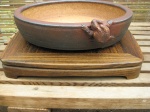Suiban Vs Daiza
2 posters
Page 1 of 1
 Suiban Vs Daiza
Suiban Vs Daiza
I'm always looking to find someone who has put in the time and effort to learn and develop an opinion on the topic. Recently I discovered such a person and wanted to pass along his thoughts, which seem to make sense to me. And that was when it comes to the use of a suiban, the use of water or sand should be limited to a situation where the stone might be naturally surounded by water or sand. Ie an island stone, desert cliffs etc.
other stones on display should use a daiza.
Was curious to hear from those at the art for awhile their thoughts on his conclusion....
other stones on display should use a daiza.
Was curious to hear from those at the art for awhile their thoughts on his conclusion....

dick benbow- Member
 Re: Suiban Vs Daiza
Re: Suiban Vs Daiza
Hi Dick... I've listened to a number of enthusiasts on suiban display as an option. In Japan, suiban with sand are most often associated with stones associated with water in the landscape. While the cooling effect of (the impression of) water might suggest suiban for summer use, suiban display is seen in every season, though perhaps more rare in deep winter. There are numerous suiban displays at the Choseki suiseki exhibit held in Kyoto in November. Japanese do not collect desert stones as suiseki, so use of a suiban for depicting desert sand is a creative use by other collectors.
In Japan, the deepest appreciation of suiseki is thought to arise when a host waters a suiseki before a guest's visit-- allowing the slow evaporation of water to incrementally change the scene over a lengthy visit.
Mr. Seiji Morimae has noted that sand in a suiban should be seen as open (empty space) space rather than specifically representing water or an earth plain. As with with empty space in an alcove, the guest's gaze is expected to fill the scene with a feeling of greater nature &, perhaps, resounding metaphor.
In the 2nd Japan Suiseki Exhibition catalog (pp. 46 & 47), a deeply black Setagawa stone of subtly rounded protrusions sits in its suiban within an alcove display. A calligraphy scroll highlighting the character yuki/"snow" is unfurled diagonally high above the stone. The viewer's first gaze of the black stone reaches the distant character, & the silence of deep snow shifts to the blanketed suiseki contour. Suiban mounting adds to the impression.
Mr. Morimae recommends a complementary plant only be added to suiseki displayed in a suiban for alcove or exhibition display. Japanese display books from Nippon Suiseki Assn. & Keido texts confirm the choice. It is found in Willi Benz book on bonsai, suiseki & kusamono display. It is a less-formal style of display than daiza mounting &, perhaps, a bit more literati in-flavor. Suiban which are especially long relative to their width (at least twice as long as wide) are referenced as tanizaki/"poem card" in shape.
Japanese enthusiasts tend to use the smallest suiban available to display a stone while still expressing empty space. Most stones (unless very strongly directional) will be placed in a suiban length approximately one-and-a-half as long as the stone's length. Western enthusiasts often choose (and remark upon choosing) suiban nearer twice the length of a stone.
In Japan, the deepest appreciation of suiseki is thought to arise when a host waters a suiseki before a guest's visit-- allowing the slow evaporation of water to incrementally change the scene over a lengthy visit.
Mr. Seiji Morimae has noted that sand in a suiban should be seen as open (empty space) space rather than specifically representing water or an earth plain. As with with empty space in an alcove, the guest's gaze is expected to fill the scene with a feeling of greater nature &, perhaps, resounding metaphor.
In the 2nd Japan Suiseki Exhibition catalog (pp. 46 & 47), a deeply black Setagawa stone of subtly rounded protrusions sits in its suiban within an alcove display. A calligraphy scroll highlighting the character yuki/"snow" is unfurled diagonally high above the stone. The viewer's first gaze of the black stone reaches the distant character, & the silence of deep snow shifts to the blanketed suiseki contour. Suiban mounting adds to the impression.
Mr. Morimae recommends a complementary plant only be added to suiseki displayed in a suiban for alcove or exhibition display. Japanese display books from Nippon Suiseki Assn. & Keido texts confirm the choice. It is found in Willi Benz book on bonsai, suiseki & kusamono display. It is a less-formal style of display than daiza mounting &, perhaps, a bit more literati in-flavor. Suiban which are especially long relative to their width (at least twice as long as wide) are referenced as tanizaki/"poem card" in shape.
Japanese enthusiasts tend to use the smallest suiban available to display a stone while still expressing empty space. Most stones (unless very strongly directional) will be placed in a suiban length approximately one-and-a-half as long as the stone's length. Western enthusiasts often choose (and remark upon choosing) suiban nearer twice the length of a stone.

Chris Cochrane- Member
 Similar topics
Similar topics» DAIZA or SUIBAN
» Daiza or Suiban for it ?
» NATURAL LAKE appearance types ...
» ... As the moonlight
» Alternatives to suiban & daiza
» Daiza or Suiban for it ?
» NATURAL LAKE appearance types ...
» ... As the moonlight
» Alternatives to suiban & daiza
Page 1 of 1
Permissions in this forum:
You cannot reply to topics in this forum






